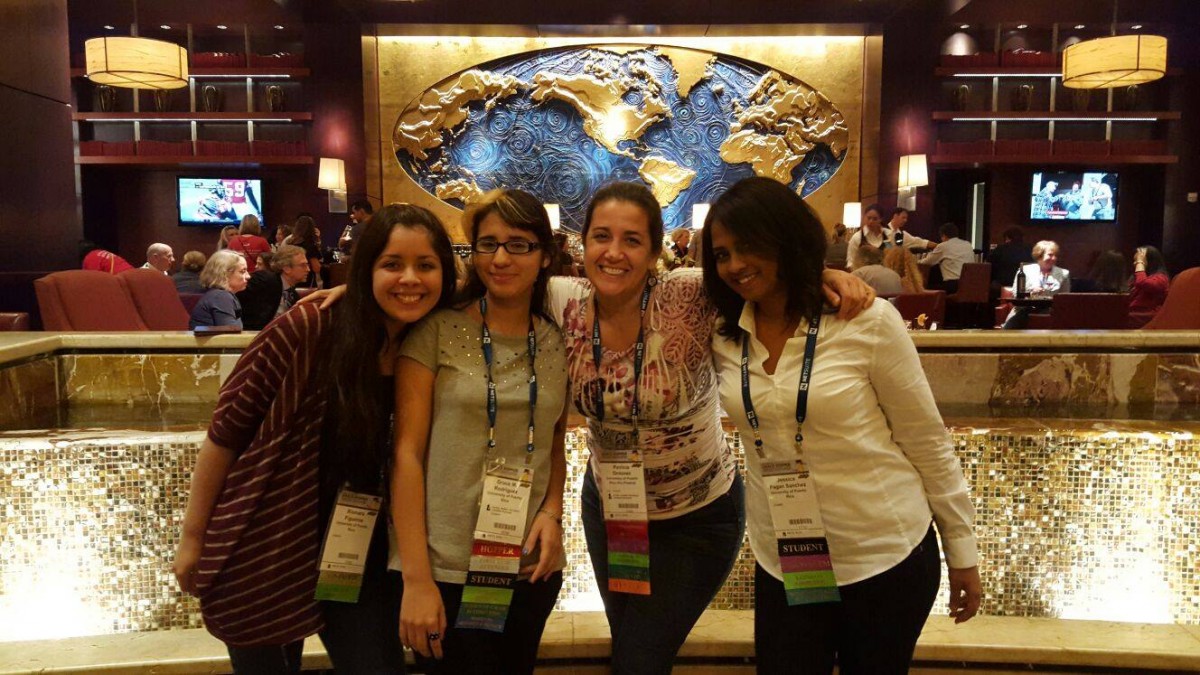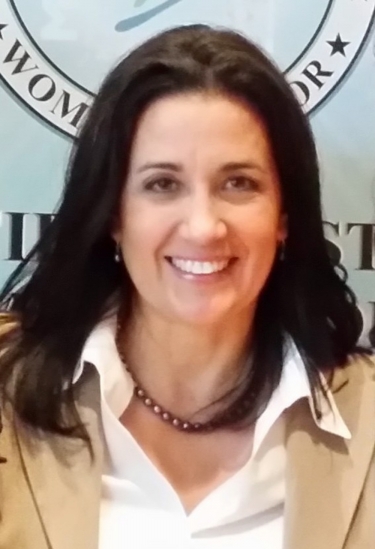Patricia Ordóñez: Propelling computer science into the health industry and equity
Submitted by Reyna I. Martínez De Luna on
The disparity of women in science, technology, engineering and mathematics (STEM) fields is still a serious issue in 2016. Computer science, a STEM discipline, is not the exception. Data from the National Science Foundation show that although the number women acquiring computer science degrees has increased since 2002, women are still a small proportion of the workforce in this field which continues to be dominated by men.
That was the case for Dr. Patricia Ordóñez, an assistant professor of computer science at the University of Puerto Rico Río Piedras, who despite her abilities and interests, took a tortuous road to obtain the position she holds today. Patricia knows too well about the unconscious bias and discrimination that women and minorities face in this field and is set on changing these statistics.
From a young age, Patricia knew she would pursue a career that involved mathematics. By the time she finished high school in the state of Maryland, where she grew up with her family originally from Colombia, Patricia had taken Calculus II.
Her proficiency in mathematics led her to take a computer science course in high school, where she discovered that she could apply math to program and understand computers. From her exposure to this course, computer science became her interest. However, Patricia chose to major in electrical engineering at Johns Hopkins University because she did not know about a program in computer science at the time of her application.

Patricia and her students in a Google Glass tutorial with her colleague from University of Maryland Baltimore County Tejas Lagvankar, now at Yahoo. Photo provided by Dr. Patricia Ordóñez)
The curves ahead
In the electrical engineering program, after Patricia attended her first course in minicomputers, she was faced with the harsh reality faced by many women in computer science. Out of 100 students in the course, only 3-5 were women. She recalls this experience as very intimidating. Furthermore, the male students seemed to have more computer science knowledge than Patricia and her female peers.
This unfortunate experience led her to switch majors, first to the mathematics program, and after a semester abroad in Austria as an exchange student, to a degree in Hispanic and Italian studies.
Although she had completed the courses of the pre-medical track, Patricia decided that medical school was not in her immediate future. While in college she worked as a phlebotomist (someone who draws blood) at a local hospital. Here she realized that patients were often not treated well due to miscommunications among staff that arose from poor management of paper medical records. Instead, Patricia decided to focus on teaching.
Her background in mathematics and Spanish opened teaching opportunities for her in the United States. She was a high school teacher for her first two jobs. In both of the schools that worked, she was hired because of her mathematics, Spanish background, and for being an experienced lacrosse and field hockey player.

Patricia and her students with Dr. Torsten Felzer and his assistant at ASSETS 2015, a confence of assistive technologies, in Lisboa, Portugal. Photo courtesy of Dr. Patricia Ordóñez.
Going back to the origin
Although Patricia loved teaching, she felt the desire to return to a technology related field. This time she joined the corporate world. She initially joined a company where she provided technical support, software training, and installation and became the editor of the 900 page technical manual for the company’s software, with the promise that she would be able to obtain further education in computer science.
Four years later, the promise of computer education never came, and instead she was discouraged from pursuing this field by her boss at the time. “I told my boss that I wanted to become a programmer and he told me he didn’t think I had the aptitude for it. Yet I was the only person in technical support who could edit checks for customers in a programming language that no one ever taught me and to this day I have never seen or identified”, Patricia recalls.
To overcome this bad experience, Patricia took some personal time to do a three-month bare-budget trip through Latin America where she stayed in the most humble of neighborhoods. It was during this trip that she recognized the power of the internet. While traveling she went to many internet cafés to write home and realized that in the different countries she visited these cafés were always crowded. In the places she visited internet cafés were the only connection to the outside world for the inhabitants. This also made her realize the disparity between her world and the one she was visiting, where few people owned computers, and even fewer had connections to the internet. It was then that she saw the potential for the Internet and computers as change agents. Since then, reducing the disparity of access became a long-term goal and lifetime passion.
Next she joined Training Etc. as a programming language course coordinator. Here Patricia found the environment for personal and professional growth she had been searching for. She performed her job duties during the day and at night took the programming courses that she coordinated as well as some night courses at the University of Maryland, Baltimore County. While at this company, Patricia first learned and then taught Java, Swing, Perl, C, C++, Linux, and Web Application Programming technologies like HTML, and Java Script. The founder of the company, Michael Saltzman, was the first to tell her she had an aptitude for programming and her colleague, Sally Hunt, was the one who most encouraged her to go back to school in her mid-thirties.

Patricia presenting at the Symposium for Health Informatics for Latin American and the Caribbean (SHILAC) in 2015. Photo provided by Dr. Patricia Ordóñez.
With this vast experience in her resume and support, Patricia applied to graduate school in the field of computer science and was accepted at the University of Maryland, Baltimore County. Inspired by her previous experience with patients in healthcare, as well as a documentary that explained how technology could greatly benefit the medicine, her dissertation research at UMBC focused on biomedical informatics. Patricia designed programs that performed multivariate analyses of clinical and physiological data to help physicians make better and more efficient decisions about the health of their patients.
Being a non-traditional graduate student, the graduate school road was not easy.
However, Patricia concedes that what she learned from professional development programs aimed at retaining minorities in science and from the fantastic mentors she made along the way were the key to her success.
Integrating what she had learned to benefit society
In her current position as an assistant professor of Computer Science at the University of Puerto Rico at Río Piedras, Patricia’s research is focused on developing computational tools to create clinical decision support systems that would allow physicians to make better diagnoses and treatment plans based on previously collected medical data. Her interest in developing a community whose aim is to apply their computational knowledge to the improvement of the medical field led her to found the Symposium for Health Informatics for Latin America and the Caribbean (SHILAC) and Hacking Health in the Caribbean.
Due to her previous experience with the unconscious bias that Latinas face in her field, Patricia is also committed to make computer science education accessible to everyone. She is part of the Expanding Computing Education Pathways consortium, a National Science Foundation funded collaboration between 12 US States and Puerto Rico that trains K-12 educators how to teach their students computer science with the goal of increasing the number and diversity of students in computing. As part of this initiative Patricia, Dr. Joseph Carroll Miranda, and other collaborators created a MOOC for high school teachers on how to incorporate computer science into the curriculum of non-CS courses, beginning the initiative of training Puerto Rican teachers in computational thinking. This group has also begun a movement called CS4AllPR that advocates and works to integrate computer science in Puerto Rico’s education system.
Also as part of her commitment to equity in computer science, Patricia founded the Kavita Project to create a spoken programming language for people with limited mobility in their hands. This project brought her into the realm of Assistive Technology and in contact with the wonderful work of the Puerto Rico Assistive Technology Program (PRATP).

Patricia's student Rafael Esparra at ASSETS 2014 with Kavita Krishnaswamy, who inspired her interest to create a spoken programming language. Photo courtesy of Dr. Patricia Ordóñez.
As a professor, Patricia has mentored 2 high school students, over 10 undergraduate students and two Master’s students. When asked what is it that she loves most about her work she says: “Taking students to conferences and opening their eyes of how many opportunities are out there in the world beyond their own reality. This experience opens their minds and makes them realize that their goals are achievable. It also teaches them the importance of networking”.
With her mentoring, Patricia’s students founded #include <girls>, an organization to promote women in computing in Puerto Rico. Now #include <girls> is collaborating with the PRATP to do an #include <a-thon> on October 22-23, 2016 to encourage more women into computing and technology by attending hackathons and working with assistive technology. Patricia is proud to see how her students have learned to network and make a positive impact in the community.
For students interested in an academic or professional career in STEM, Patricia emphasizes the need for finding and maintaining relationships with diverse mentors. The fact that a mentor may look like you does not necessarily mean that this person will be a good mentor or that they would not lose faith in you. Her best advice is to find as many mentors as possible, each with different perspectives that can help you move forward and achieve your goals.
Patricia’s career and journey exemplifies what it really means to persevere and excel. She is a true Borinqueña and Puerto Rico is proud to have her as an adopted daughter that is invested in making computer science education and opportunities accessible to everyone in the archipelago and beyond.
If you would like to learn more about Patricia and her work visit her profile or her personal webpage.

Patricia with her students at the Grace Hopper Celebration of Women in Computing in Houston, Texas in 2015. Photo courtesy of Dr. Patricia Ordóñez.
In 2014 Patricia was interviewed by NPR about the current situation of women in computer science. You can listen to her interview here:








